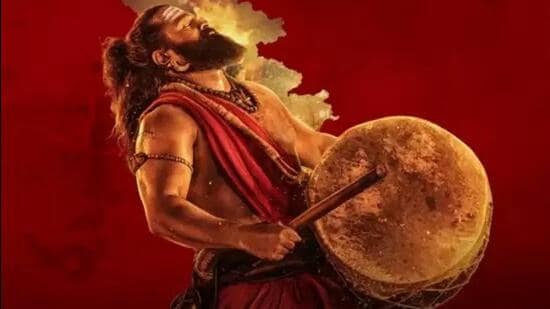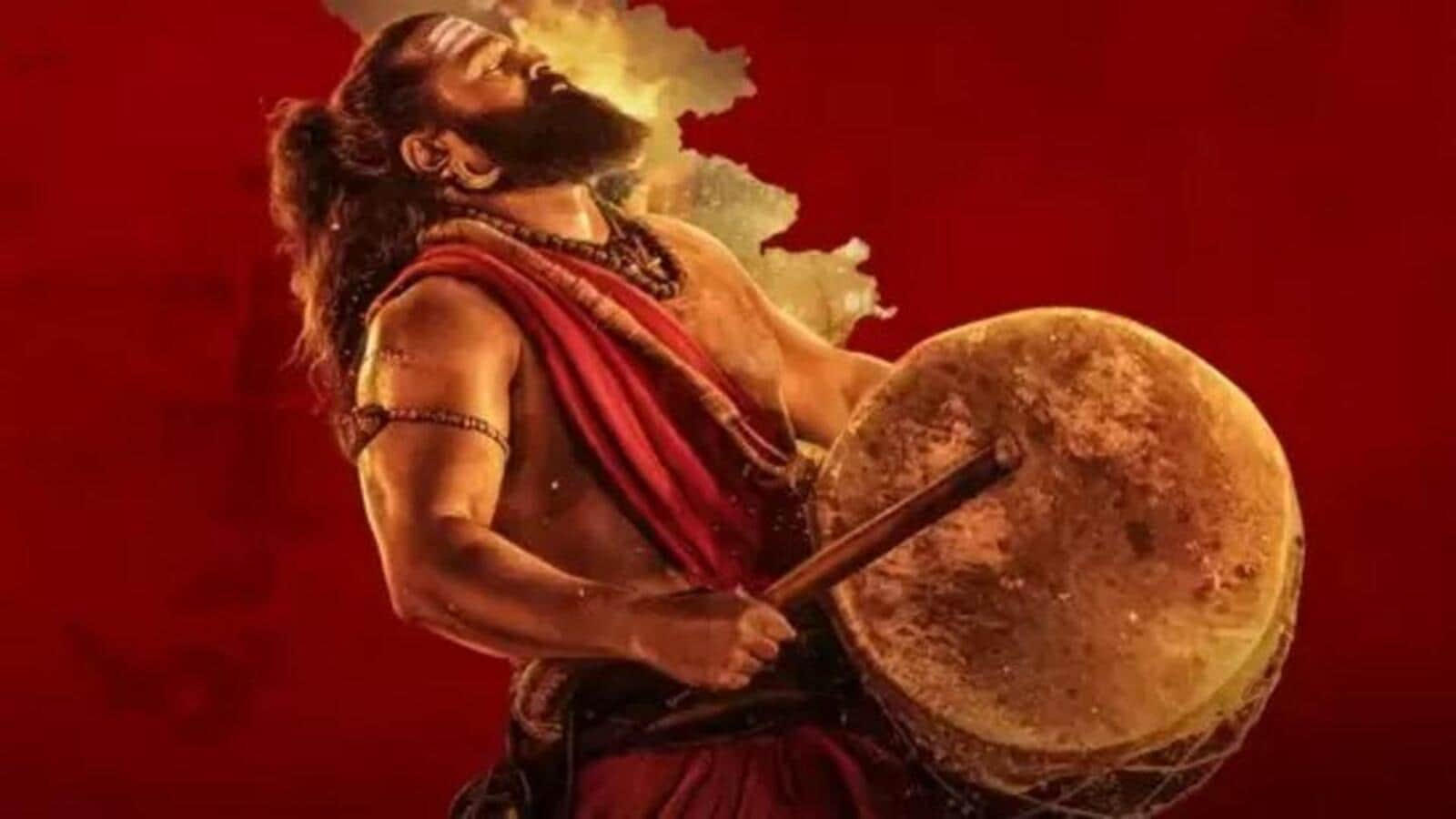The deep sound of a thundering invocation, a warning, a deep cry of pain rings in our ears long after we’ve left the movie hall. The forest god in Rishab Shetty’s Kantara films continues to roar. The first, Kantara (2022), and now, its prequel, Kantara: Chapter 1 are runaway hits. The latter, which released in Indian theatres on October 2, has become the highest grossing Indian film of 2025 with box office returns surpassing ₹500 crore within a week, based on figures released by its producer, Hombale Films. The ‘woooooaaaaavvvvv!” is at once wonder and outrage — a phonetic equivalent of the primal emotion Shetty, writer-director-lead actor, imbues the Kantara films with.
 The first, Kantara (2022), and now, its prequel, Kantara: Chapter 1 are runaway hits.
The first, Kantara (2022), and now, its prequel, Kantara: Chapter 1 are runaway hits.
Granted Kantara is no Ne Zha, the animated Chinese film series adapted from a 16th century mythological novel on gods and demons, whose second film released in January and grossed over $2 billion worldwide, but the genre is a storytelling paragon. In times of great military strife, economic uncertainty brought on by rapidly changing technological advances and a climate crisis looming large, we seem to be deriving deep comfort from mythology, fantasy, hero/legend-based narratives. Of the top 10 highest grossing films this year itself, at least four are from this genre, or are genre adjacent — Superman, one of them, is certainly a modern-day myth.
The human-versus-nature conflict has unparalleled cultural currency in the post-pandemic world. Both Kantara and Kantara: Chapter 1 are based on nature as a force to be revered. Its wrath is to be feared and prevented. This mirrors our social preoccupation with wellness, of the self as well as the planet’s. It’s too ubiquitous and widespread to discount the hold that the “natural” seems to have on us. Its ability to heal and balance us is a truth universally acknowledged.
However, box offices, like washing machines, run on fuzzy logic. Formulae work only upto a point. Story is usually queen, but not always. Stars carry the load, a lot of the time. But mythology has always worked in Indian films — in recent times, more than war, it appears. In box office collection, both the Kantara movies, especially Kantara: Chapter 1 did much better business than the two Hrithik Roshan-starrers, War (2019) and War 2 (2025).
Baahubali, Stree, Hanu-Man, Mahavatar Narasimha, Lokah: Chapter 1 — mythology and folklore, superstition, half-truths and urban legends have attracted Indian audiences to the movie theatre more than any other genre in the post-pandemic world. In Malayalam cinema, Lokah: Chapter 1 – Chandra (2025) draws from the Malayalam folk legend of Kalliyankattu Neeli. Director Dominic Arun is currently working on a five-part franchise, which brings to life more characters from Malayalam folklore.
Another mainstream example that worked pan-India like Kantara has done is Ayan Mukherjee’s Brahmastra (2022) from Karan Johar’s Dharma Productions banner.
To understand the Indian willingness to surrender to the comforting familiarity of mythology, let’s think back to two storytelling milestones: The success of the cringeworthy production of the 1975 blockbuster Jai Santoshi Maa or the mytho-fiction rage that author Amish unleashed with his 2012 bestselling book, The Immortals of Meluha.The first was released months after the then Prime Minister Indira Gandhi declared Emergency following months of social and political unrest. Protests over unemployment, poverty, crony capitalism, led by students and independence leaders alike rained fire over the central government. In the case of the latter, closer to many of us than ‘75, the nation-wide protests over corruption as well as the national outpouring of grief over the death of a 23-year-old gangrape victim greeted Tripathi’s book that humanised the figures of gods and goddesses, turning powerful figures into everyday people (albeit, who lived in a mythical land a long time ago), filled with a desire to do good and be good.
Indeed, familiarity with mythological and folklore stories offers filmmakers a unique advantage. Audiences already know the basic character traits, moral frameworks, and narrative arcs — filmmakers get to creatively present them in new, visually spectacular ways. The only demanding task for writers is world-building.
The Kantara movies have done impeccably, so far.
Kantara: Chapter 1, like the first film, is an action-filled vengeance drama, with VFX calisthenics that’s significantly better than the usual, and a hero so brawny and macho that he borders on caricature. These are South Indian cinema tropes as old as ’70s’ Rajnikanth movies. But what sets these films apart is what Shetty and his producing partner, the Benguluru-based Hombale Films, do to the basic storyline, using Karnataka’s Bhoota Kala traditions observed in tribal communities of the state. The emotional centre of the second film is the ancient bond between humans and divinity that tribal knowledge repositories believe sustains the amity between man and nature. Shetty treats this thread, the thread that alone elevates Kantara to poetic proportions, with reverence and beauty. He uses sonic elements like tinkling anklets coming from the depth of thick rainforests and the thunderous sound of the Forest God, folklore from the Tulunadu region of Karnataka, art forms like Kambala racing and Yakshagana with rigour, respect and sensitivity.
The first film is focussed on the rise of the hero, Shiva (Shetty), who is content with locally brewed inebriates, boar and fish, and smoking (up). He is likened to the Hindu god Shiva — the tree house he escapes to is called Kailasa. In the new film, the entire forest and its inhabitants — the family and community of Shiva — embody nature. The forest and its spirit are the hero, the mythology and the folklore. Kantara: Chapter 1 also begins centuries ago, during the reign of the Kadamba dynasty.
The script’s scope in the prequel is wider and dilated in its architecture. As director, Shetty thrusts the story’s imaginative artistry thrillingly, gleefully and expensively into the fore. Bristling with every hallmark of fantasy fiction including cliff-crowning structures with pointed turrets, wild animals rising ferocious to human triggers, crowded rite bazaars, palaces, and most evocatively, the sounds and visuals of the forest, both films plunge the viewer into a state where there is no state except the lawless interplay of violent power.
A myth is a traditional story, especially one concerning the early history of a people or explaining some natural or social phenomenon and typically involving supernatural beings or events. Inherent in the anatomy of mythological stories is the message, ‘You shall reap what you sow’. Shetty makes the mythology genre smarter by going beyond gods and goddesses and moral truisms to the central preoccupation of our times: The clash between nature and human greed. Mythology has a way of making its characters look more bewitching every time you go through it. We have grown up with oral traditions of storytelling of the epics — it is almost going home to grandma.
According to psychoanalyst and author Sudhir Kakar, Indians love mythology because it is deeply integrated into the Indian psyche, especially during childhood, which fosters a lasting connection to mythical figures and spiritual narratives. He argued in his book The Inner World that this upbringing, which encourages a long period of living in a “mythical, magical world”, leads to a spiritual orientation and a belief in things like astrology or the power of gurus. He argued that for most Indians, myth is more psychologically potent than historical facts. The Inner World is like an exploration of the collective Indian cultural psyche: How these ancient stories shape identity, making them more real to many individuals than contemporary events.
For younger audiences, mythology serves as an antidote to the new world order, which is obsessed with creating something-new, which is meant to replace the something-recent at all times. Mythology is a gateway into a world that is at once primal and desirable, rooted in local tradition, yet profoundly universal in spirit. In the content eco-system of ever-growing streaming platforms, where watching a drama unfold or even creating an audio-visual story just requires just a swipe, a click or a prompt, mythology makes our backstories meaningful and sweeping in scope. It’s everywhere, from Hollywood studios and anime series to pocket fiction, and in a country where mythology has always been mass and open to myriad interpretations, there’s no better time for an mythology stories ecosystem to emerge and thrive. Rishab Shetty has the magic formula. No other Indian movie in recent memory has made the sanctity and power of nature more irresistible than the Kantara movies.
(Sanjukta Sharma is a Mumbai-based writer and editor.)
